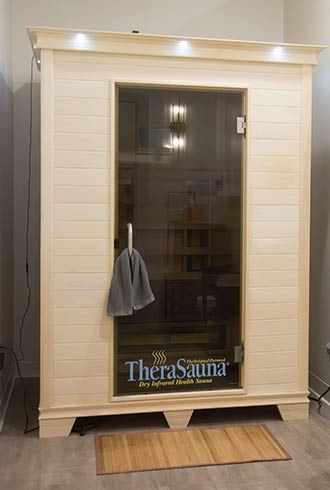Is an Infrared Sauna Better Than a Traditional Sauna?
Supporters of infrared saunas say the heat penetrates more deeply than warmed air. This allows you to experience a more intense sweat at a lower temperature and stay in the sauna longer.
There’s nothing quite like a 20-minute sweat session in a sauna. You feel more relaxed and rested after you’re done, and the heat helps relieve sore muscles and improves your overall health and well-being.
But if the high temperatures of a traditional sauna are too much to handle, an infrared sauna may offer the benefits of a sauna without the extreme heat.
What is an infrared sauna?
Unlike a traditional sauna, infrared saunas don’t heat the air around you. Instead, infrared lamps, which use electromagnetic radiation, warm your body directly.
“These saunas use infrared panels instead of conventional heat to easily penetrate human tissue, heating up your body before heating up the air,” physical therapist Vivian Eisenstadt, MAPT, CPT, MASP, said.
An infrared sauna can operate at a lower temperature — usually between 120˚F and 140˚F (49°C and 60°C) — than a traditional sauna, which is typically between 150˚F and 180˚F (66°C and 82°C).
Some manufacturers claim that in an infrared sauna, only about 20% of the heat goes to heat the air and the other 80% directly heats your body.

What are the supposed benefits of using an infrared sauna?
The supposed benefits of using an infrared sauna are similar to those of a traditional sauna. These include:
- better sleep
- relaxation
- detoxification
- weight loss
- relief from sore muscles
- relief from joint pain such as arthritis
- clear and tighter skin
- improved circulation
- relief from chronic fatigue syndrome symptoms
People have used saunas for centuries for all sorts of health conditions. While there are several studies and research on traditional saunas, not many have looked specifically at infrared saunas.
Some research has shown that using an infrared sauna may be beneficial for cardiovascular health and muscle recovery after a workout. However, the lack of solid evidence and widespread studies about the possible benefits means it’s up to you to decide if an infrared sauna is right for you.
Even if your sweat session doesn’t do all the things it claims to do, at least it still feels good. Plus, it can contribute to your overall health and well-being by helping you relax, loosening up stiff or tight muscles, reducing joint pain, and giving you some much-needed time to yourself.
While available research does suggest that the risks associated with using an infrared sauna are relatively low, it is possible to experience overheating and dehydration, so it’s important to exercise caution. Using a sauna may also interfere with some medications.
Healthcare professionals recommend avoiding a sauna if you’re pregnant or have low blood pressure.
How do you use an infrared sauna?
You may be able to do infrared sauna treatments at a health club, spa, or doctor’s office, or you can purchase or build one in your home. If you decide to try an infrared sauna, it’s important to know that they don’t come with universal instructions.
There are some things to keep in mind, but ultimately, how you use an infrared sauna is your choice. Here are some tips to get started:
Stay hydrated: Make sure you’re hydrated before going into an infrared sauna. Be sure to drink a glass of water before your session. You can also bring water into the sauna, especially if you’re sensitive to higher temperatures.
Begin with a lower temperature: The average temperature for an infrared sauna ranges from 100˚F to 150˚F (38°C to 66°C). If this is your first time, start with 100˚F (38°C) and gradually work up to a higher temperature.
Start small: For first-time users, it’s best to start small, like 5 minutes at a time, and gradually add time to each session. Just don’t stay in longer than 15 to 20 minutes at a time. Saunas come with a timer, so make sure to set it. You don’t want to stay in there too long and risk becoming dehydrated.
Take time to cool down: When your session is done, be sure to let your body cool down. Once you’ve cooled down, you can take a shower or bath. Just make sure to hydrate afterward.
Wear what you want: How you dress is your choice. Some people wear bathing suits, while others prefer going in naked.
Relax: Read, meditate, listen to music, or visit with friends. Just don’t go to sleep.
Most facilities that offer infrared sauna treatments recommend using the sauna 3 to 4 days per week. If you’re in good health and can tolerate using the sauna 4 days per week, daily sauna use may be safe for you.
What should you know before trying an infrared sauna?
There are a few things to know before your first session:
- Avoid using an infrared sauna if you’ve been drinking alcohol.
- If you feel ill or have a fever, wait to use the sauna until you’re feeling better.
- Using an infrared sauna will cause you to sweat a lot, so you may feel lightheaded. If this happens, make sure to get up slowly, sit down once leaving the sauna, and hydrate.
- Drink water immediately after finishing your session, and wait for your body to cool down before doing anything else.
If after using any sauna you experience a headache, a fever of 104°F (40°C) or higher, confusion, or a racing heart, seek medical attention, as you may be experiencing a heatstroke.
If you have any health conditions such as high blood pressure or heart disease, get cleared by your doctor before your first session. Even though infrared saunas are fairly safe, you don’t want to take any chances when it comes to your health and safety.
Written By Sara Lindberg


